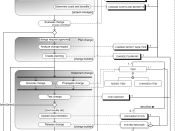INTRODUCTION Organisations today recognise the need for change. The "new economy"� of the twenty-first century requires organisations to adapt to changing markets, innovate new products or services, expand customer bases, trade or deliver goods and services in new ways like e-commerce, manage rapid growth or decline or become global in their outlook. The purpose of organisational change is to improve organisational efficiency, effectiveness and productivity. To draw on the metaphor of an organisation as a living organism, an organisation has to change in order to survive; not changing could mean death.
Two main forms of change that this essay will look at are: Organisational Development (OD) and Organisational Transformation (OT). This essay will also look at the difference between OD and OT.
ORGANIZATIONAL DEVELOPMENT (OD) What is organizational development? Over the years there have been a number of definitions provided by various authors, they all suggest that the central characteristic of OD is the fusion between knowledge and organizational practice.
" A system wide application of behavioral science knowledge to the planned development and reinforcement of organizational strategies structures and processes for improving an organizations effectiveness"� (Cummings and Worley, 1993, page 2).
"OD should improve the internal operations of the organisation by opening up communication, by decreasing internal destructiveness, such as win-lose conflicts, and by increasing creativity in problem solving."� (Berry and Houston, 1993, page 514) LEVIN'S THREE PHASE MODEL AND ORGANIZATIONAL DEVELOPMENT Practitioners argue there are three models that underpin any OD effort. They are, action research model, Levin's three-step model of system change and phases of planned change. Managers can use change models as valuable tools in facilitating the process of change.
Lewin's (1958, in Burke, 1994) three-phase model of change uses an ice cube analogy, unfreezing, movement and refreezing. This model, though simple, ultimately results in new...


